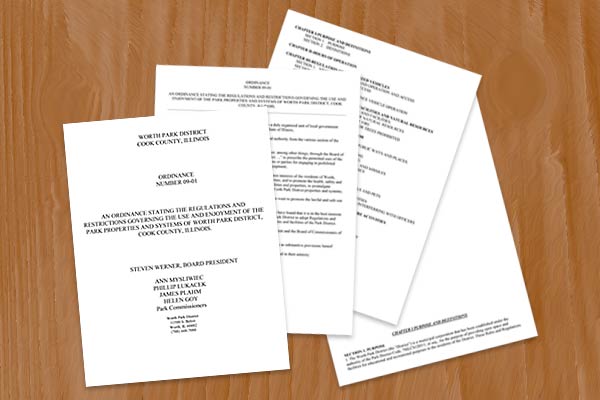 Ordinances Specify Ground Rules
Ordinances Specify Ground Rules
Ordinances establish permanent rules and regulations for use of member property and facilities — including clarification and communication of “intended and permitted” use. Violation of an ordinance is often critical evidence in the defense of a personal injury action. Such a violation establishes misuse or unauthorized use of member property. In addition, violation of an ordinance can establish that your agency owed no duty to the injured party. (Remember that the Tort Immunity Act states that local public entities only owe a duty to maintain their property [including leased property] for patrons who are both intended and permitted users.)
“Ordinances let visitors know how and when they can enjoy parks, facilities and grounds,” explains Dane Mall, PDRMA Risk Management Services Manager. “Members should use them to communicate key information such as hours of operation, intended and authorized use of equipment and facilities, restrict access, specify age limits, as well as other important information for the safe and proper use of member property.”
Your ordinances must be readily accessible, available and communicated to your community — through your website, Facebook page, brochures, and onsite signage. When clearly posted, well-written ordinances maximize safety and minimize liability. Specifying “ground rules” can identify who are “intended and permitted” users of facilities and who are not.
“They’re a strong line of defense when someone who should not have been using equipment or a facility suffers an injury,” Mall says. “The key is effective and meaningful communication.”
How do ordinances help? One real-life example involved a member’s designated sled hill, which had clear and conspicuous signage about the member’s ordinance designating hours of operation — from dawn to dusk. When a patron was injured using the sled hill at 10 p.m. , PDRMA successfully defended the claim by using the ordinance to establish the patron was not a “permitted and intended” user of the sled hill at the time of the injury — a first-base tag out on behalf of the member.
“If the injured patron was an 'intended and permitted' user at the time of the injury, he would get to first base in the litigation game, and the game continues,” explains Steve Kleinman, PDRMA General Counsel. “But if not, he strikes out at the plate.” However, if the injured party can say "what ordinance?” because finding it is too difficult, then your ordinance will be less effective in promoting safety and establishing that an injured party was not an intended and permitted user. That’s why it is critical that your agency conspicuously posts and communicates key ordinances to the public. |

